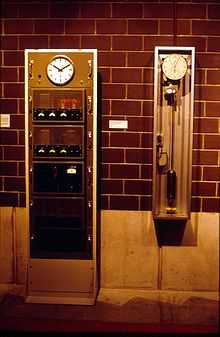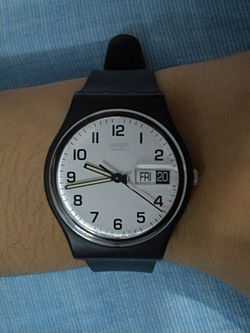Quartz crisis
The Quartz Crisis, (also known as the Quartz Revolution),[1][2] is a term used in the watchmaking industry to refer to the economic upheavals caused by the advent of quartz watches in the 1970s and early 1980s, which largely replaced mechanical watches.
It caused a decline of the Swiss watchmaking industry, which chose to remain focused on traditional mechanical watches, while the majority of world watch production shifted to Asian companies that embraced the new technology.
Swiss hegemony

During World War II, Swiss neutrality permitted the watch industry to continue making consumer time keeping apparatus while the major nations of the world shifted timing apparatus production to timing devices for military ordnance. As a result, the Swiss watch industry enjoyed an effective monopoly. The industry prospered in the absence of any real competition. Thus, prior to the 1970s, the Swiss watch industry had 50% of the world watch market.[3]
In the early 1950s a joint venture between the Elgin Watch Company in the United States and Lip of France to produce an electromechanical watch – one powered by a small battery rather than an unwinding spring – laid the groundwork for the quartz watch.[4] Although the Lip-Elgin enterprise produced only prototypes, in 1957 the first battery-driven watch in production was the American-made Hamilton 500.
In 1954, Swiss engineer Max Hetzel developed an electronic wristwatch that used an electrically charged tuning fork powered by a 1.35 volt battery. The tuning fork resonated at precisely 360 Hz and it powered the hands of the watch through an electro-mechanical gear train. This watch was called the Accutron and was marketed by Bulova, starting in 1960. Although Bulova did not have the first battery powered wristwatch, the Accutron was a powerful catalyst, as by that time the Swiss watch manufacturing industry was a mature industry with a centuries-old global market and deeply entrenched patterns of manufacturing, marketing and sales.
In 1962, the Centre Electronique Horloger (CEH) was established in Neuchâtel to develop a Swiss-made quartz wristwatch, while simultaneously in Japan, Seiko was also working on an electric watch and developing quartz technology.[5]
Technological revolution
In the late 1950s and early 1960s, both Seiko and a consortium of Switzerland's top firms competed to develop the first quartz watch. One of the first successes was a portable quartz clock called the Seiko Crystal Chronometer QC-951. This portable clock was used as a backup timer for marathon events in the 1964 Summer Olympics in Tokyo. In 1966 prototypes of the world's first quartz pocketwatch were unveiled by Seiko and Longines in the Neuchâtel Observatory's 1966 competition.[6]
On 25 December 1969, Seiko unveiled the quartz Astron, the world's first quartz watch.[6][7] The first Swiss quartz analog watch—the Ebauches SA Beta 21 containing the Beta 1 movement—arrived at the 1970 Basel Fair.[6][8] The Beta 21 was released by numerous manufacturers including the Omega Electroquartz.
On 6 May 1970, Hamilton introduced the Pulsar - the world's first electronic digital watch.[9]
In 1974 Omega introduced the Omega Marine Chronometer, the first watch ever to be certified as a Marine Chronometer, accurate to 12 seconds per year using a quartz circuit that produces 2,400,000 vibrations per second.
In 1976 Omega introduced the Omega Chrono-Quartz, the world's first analogue/digital chronograph, which was succeeded within 12 months by the Calibre 1620, the company's first completely LCD chronograph wristwatch.
The rise of quartz in the 1970s
%2C_1979.jpg)
Despite these dramatic advancements, the Swiss hesitated in embracing quartz watches. At the time, Swiss mechanical watches dominated world markets. In addition, excellence in watchmaking was a large component of Swiss national identity. From their position of market strength, and with a national watch industry organized broadly and deeply to foster mechanical watches, many in Switzerland thought that moving into electronic watches was unnecessary. Others outside of Switzerland, however, saw the advantage and further developed the technology,[10] and by 1978 quartz watches overtook mechanical watches in popularity, plunging the Swiss watch industry into crisis while at the same time strengthening both the Japanese and American watch industries. This period of time was marked by a lack of innovation in Switzerland at the same time that the watch-making industries of other nations were taking full advantage of emerging technologies, specifically quartz watch technology, hence the term Quartz Crisis.
As a result of the economic turmoil that ensued, many once-profitable and famous Swiss watch houses became insolvent or disappeared. This period of time completely upset the Swiss watch industry both economically and psychologically. During the 1970s and early 1980s, technological upheavals, i.e. the appearance of the quartz technology, and an otherwise difficult economic situation resulted in a reduction in the size of the Swiss watch industry. Between 1970 and 1988, Swiss watch employment fell from 90,000 to 28,000.[6]
Outside of Switzerland, the crisis is often referred to as the Quartz Revolution, particularly in the United States where many American companies had gone out of business or had been bought out by foreign interests by the 1960s. When the first quartz watches were introduced in 1969, the United States promptly took a technological lead in part due to microelectronics research for military and space programs. It was American companies like Texas Instruments, Fairchild, and National Semiconductor, who started the mass production of digital quartz watches and made them affordable.[1] It did not remain so forever; by 1978 Hong Kong exported the largest number of electronic watches worldwide, and US semiconductor companies came to pull out of the watch market entirely. With the sole exception of Timex, the remaining traditional American watch companies, including Hamilton, went out of business and sold their brand names to foreign competitors.[11]
The renaissance, the Swatch, and the future of timekeeping

By 1983, the crisis reached a critical point. The Swiss watch industry, which had 1,600 watchmakers in 1970, had now declined to 600.[12] A research consortium, the Swiss ASUAG group (Société Générale de l'Horlogerie Suisse SA), was formed to save the industry and the result was launched in March 1983 – the Swatch. The Swatch would be instrumental in reviving the Swiss watch industry giving a new bill of health to all brands concerned and gave rise to what would become the Swatch Group – the largest watch manufacturer in the world.[13] The Swatch was sealed in a plastic case, sold as a disposable commodity with little probability of repair, and had a small number of moving parts (51) compared to about 91 for mechanical watches. Furthermore, production was essentially automated, which resulted in a higher profitability.[14] The Swatch was a huge success; in less than two years, more than 2.5 million Swatches were sold.[5]
The larger global market still largely reflected other trends, however. In the US domestic market, for example, the Swatch was something of a 1990s fad resting largely on variety of colors and patterns, and the bulk of production still came from offshore sites such as China and Japan, in digitally-dominated or hybrid brands like Casio, Timex, and Armitron. Paradoxically, the quartz revolution drove many Swiss manufacturers to seek refuge in (or be winnowed out to) the higher end of the market, such as Rolex, Patek Philippe, Bulova, and the like. A few brands aimed further up in the midrange toward the high hundreds but still avoiding the realm of the high end mechanicals, which might run from several thousand to $50,000 and higher.
References
- ↑ 1.0 1.1 Smithsonian: The quartz revolution revitalized the U.S. watch industry.
- ↑ Harvard Business Review: Seiko Watch Corporation: Moving Upmarket
- ↑ David Landes, Revolution in Time: Clocks and the Making of the Modern World, Cambridge, Massachusetts, 1983.
- ↑ Rene Rondeau, The Watch of the Future: The Story of the Hamilton Electric Watch, Corte Madera, California, 1992, pp. 50.
- ↑ 5.0 5.1 Markets in Time: The Rise, Fall, and Revival of Swiss Watchmaking
- ↑ 6.0 6.1 6.2 6.3 1969: Seiko’s Breakout Year.
- ↑ Timepieces: masterpieces of chronometry By David Christianson
- ↑ Frei, Armin H., "First-Hand:The First Quartz Wrist Watch", IEEE Global History Network, 2009.
- ↑ Engineering time: inventing the electronic wristwatch
- ↑ Cooke, P. and Hastings, J., New Industries: Imperative for Agriculture's Survival, Regional Australia Summit, Oct 27-29, 1999 at page 8.
- ↑ The Market for Watches and Clocks (New York, 1992), 1, 86.
- ↑ Swiss News, April, 2005 by Elizabeth Meen
- ↑ Koltrowitz, Silke; Reid, Katie (23 February 2009). "Swatch Group still sees H2 recovery - paper". Reuters. Retrieved 2009-03-01.
- ↑ Bold, Kathryn, "Swatchdogs on the Lookout : Promos give collectors a chance to meet the inventor and pick up some of the 'vintage' timepieces for face value", Los Angeles Times, January 03, 1992